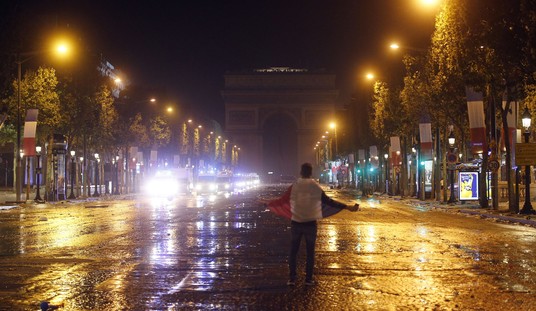A growing number of Americans are beginning to think that global warming alarmism is little more than some sort of hippie plot to drag us back to the Stone Age. Or, failing that, at least drag us back to the Hippie Age. And what with the abject failure of the international community to reach any kind of binding agreement at the recent Copenhagen climate conference, and the growing unlikelihood that the U.S. Senate will pass any bill to combat that chimerical foe Anthropogenic Global Warming, coupled with the scandal-a-minute collapse of any scientific “consensus” that we’re even changing the climate after all, the alarmists are now looking at a bleak future of their grand scheme devolving into nothing more than a passing fad along the lines of Hula Hoops or the Macarena.
The same thing happened in the 1960s. The early anti-war protests against U.S. involvement in Vietnam were fervent, sincere, and convinced of their eventual efficacy. But as months turned to years and the Johnson administration not only ignored the protests but escalated the war at every opportunity, it became painfully obvious that the anti-war movement of the mid-’60s had failed. It may have gotten a lot of protesters laid, but it did nothing to actually stop the war. By the time the late ’60s rolled around — i.e., the Hippie Age — most protesters had little or no expectation that their antics would influence Nixon to stop bombing Indochina (or whatever other shenanigans he was up to that week); rather, protests had become mostly an excuse to party. Or, seen from the reverse angle, most public musical events for the younger generation by then acquired a political overtone, so that you were no longer just dancing for the fun of it, but were now “dancing for peace.”
 |
| Dancing for peace, 1969. |
My thesis is that once any movement begins to engage in hollow, ridiculous and futile gestures (such as “dancing for” anything), it’s an indicator that the movement has run out of steam and will soon go extinct. It is therefore with great interest that I’ve been noticing not just the strange new outbreak and continuous barrage of climate change dances but more significantly an upcoming lecture being given at U.C. Berkeley entitled Mitigating Global Warming Through Art — Exploring the Importance of Music for the Change of Lifestyles. The listing for the talk (given by visiting lecturer Maximilian Mayer at U.C. Berkeley’s Institute of European Studies) notes that “Music in general and art in particular seems to be a promising Archimedean point for multiple new life styles. Performing music and dancing combine the advantages of those three alternative approaches. Additionally, they may be powerful enough to substitute the culture of consumerism since they enable a creativity-based self-autonomy as well as cultural self-sufficiency.” In other words, not only have the global warming alarmists started dancing in a last-ditch attempt to save the planet, but they have now even developed an academic pseudo-scientific theory as to why dancing is a necessary and perhaps the only remaining way to prevent the climate from changing.
 |
| Mass climate change dance, Belgium, 2009. |
The listing does not explain exactly which kind of dancing will be employed to stop global warming. One assumes that it will look something like an Isadora Duncan performance with nymphs in flowing gauze leaping about and weeping for Mother Earth. Or perhaps it will take the form of a hip-hop robot dance, as stiff and mechanical as Al Gore. Or maybe we’ll all be expected to link arms in a massive Greek folk dance circling the entire globe, neutralizing the carbon dioxide molecules with our laughter.
 |
| Ghost Dance, 1890. |
It’s a bad enough sign that your movement must resort to dancing in order to achieve its aims — just as in 1890 when the Native Americans performed the Ghost Dance in one last-ditch effort to stop the white man’s conquest of America, which by then was already a fait-accompli. But it’s a dire sign that your belief system is in its latter days when your philosophers intellectually justify dancing as the only remaining course of action.
Of course, I’m being a little cruel, since the climate dancers (one hopes) don’t actually think that the dancing itself will directly fix the problem. Rather, a closer analysis of the lecture shows that the act of dancing is intended to not only serve as a propaganda tool but more importantly will help to “enable a creativity-based self-autonomy” which will then allow us to “overcome the hegemonic consumerist environment.” Also, get laid.
The full description of the lecture merits close reading — not to mention a bit of fisking:
If we can trust the outcomes of contemporary climate models, huge cut downs of global greenhouse gas emission are immediately required.
You lost me at “If.”
In fact, a reduction of more than 80 percent is needed until the mid-century. In other words, we are facing another industrial revolution.
However, the goal of this new “industrial revolution” (quite unlike the first one) is to do for industry what China’s “Cultural Revolution” did for culture.
While technological innovations will doubtlessly contribute to materialize this aim, efficiency gains, leapfrogging and so on won’t deliver the promised volume of mitigation. Instead, ecological modernization largely failed to realize an environmentally friendly growth on a global scale, because ever-expanding consumption/production patterns have out-weighted efficiency gains by far. Under these circumstances profound changes in our lifestyles have to become a centerpiece of the mitigation strategy in the industrialized world.
As the Copehagen Stalemate Talks demonstrated, no nation is willing to be the first to volunteer for “profound changes in our lifestyles,” with the conference itself ending up like a comedy routine: “You first.” “No, you first.” “After you.” “Be my guest.” “Go right ahead.” “Apres vous” ….
Whatever the new low carbon life may look like, simplification is a central issue. From the vantage point of the actor-network theory, simplification means to reduce the complexity of collectives. In order to simplify our life has to decrease the number of “things” one is entangled with in his/her daily life. Yet, one cannot substitute something with nothing.
I will discuss four paths such a change of lifestyle could possibly take. Comparing those approaches that can be cartooned as “back to nature”, “back to religion”, or “back to community”, my main attention is focused on the arts, and music in particular. The role “performing music” plays for the simplification is explored by means of various historical and anthropological approaches, personal experiences, and philosophical considerations. How are music and human agency related? What is the relevance of music for revolutions and societal cohesion? On a personal level, we are looking for an utterly new way of happiness and a quotidian practice that provides postmodern urban dwellers with sense and orientation.
Music in general and art in particular seems to be a promising Archimedean point for multiple new life styles. Performing music and dancing combine the advantages of those three alternative approaches. Additionally, they may be powerful enough to substitute the culture of consumerism since they enable a creativity-based self-autonomy as well as cultural self-sufficiency. “Back to art” could even open up the path to self-induced simplification in order to overcome the hegemonic consumerist environment. Under the condition of a climate change constrained planet, humanity should not be primarily treated according to the logic of homo oeconomicus as emission trading regimes and proposed carbon taxes imply. Rather it might be best envisioned as communities of artists.
People get paid to come up with this tripe. And, seeing as this lecture is funded by a state public university, taxpayers like me are footing the bill. As usual.









Join the conversation as a VIP Member